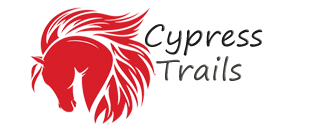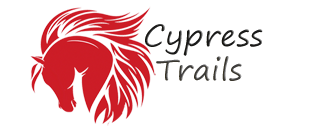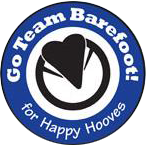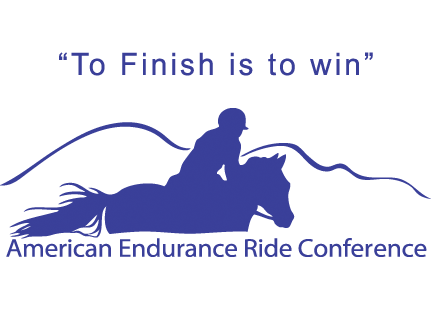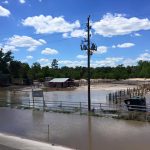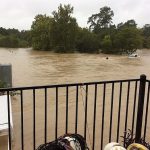by Karen Braschayko
Darolyn Butler has had a long career in several aspects of the equine industry, from winning rodeo queen pageants to selling Western wear and producing instructional videos on horsemanship. Today, she has knitted her love of endurance riding into a company of teaching clinics, leasing horses and training other endurance racers. From her ranch, Cypress Trails Equestrian Center north of Houston, Texas, she runs her family business, conditioning endurance horses while leading adventure trail rides and giving riding lessons.
Butler also uses her distance riding skills to serve the community. She helped form the Airport Rangers group at George Bush Intercontinental Airport (IAH), a unique program enabling fellow equestrians to enjoy hundreds of miles of pleasure trails while patrolling the vast airport grounds.
Butler began endurance riding at 31, when a trainer told her she should hurry up if she wanted to try it. Now 62, she has competed all over the Americas and on several continents in FEI endurance races. She has earned dozens of wins, including gold and silver medals, and has over 34,000 competitive miles under her saddle.
Having survived the devastation of two major floods and a shattered pelvis, Butler works as hard as ever. She travels widely and coaches other endurance riders. Here she tells us about conquering 100-mile races and the many ways to make a living with horses.
Karen Braschayko for Equitrekking: When did you start riding? What is your background with horses?
Darolyn Butler: Well, my mom rode while pregnant with me, if that counts! As a toddler I would cry when taken off of a horse. So I guess I was imprinted from a very early age. My parents owned a farm and ranch in Pauls Valley, Oklahoma. We always had horses, and riding was always available. I had and rode my own horse starting at three years old. I broke my first horse when I was 14, with some assistance, and started barrel racing soon after.
I followed in the footsteps of my older sisters (there were 5 of us) in pursuit of rodeo queen titles, and I was fortunate to win Miss Rodeo Oklahoma. Then I won the horsemanship division in the Miss Rodeo America Pageant. That was really very special to me, as I had not been fortunate enough to learn from professional trainers. I was mainly a self-taught rider who’d had the advice of a few friends.
In 1970, I was privileged to earn the position of Miss Ford Country. I was a paid cowgirl persona who made appearances at rodeos and community festivals. This was the ultimate dream job. Ford furnished me a big convertible, a horse trailer, my wardrobe and a daily stipend. I got to do my favorite things in the world, going to rodeos and riding in parades. For two years, I traveled through Oklahoma and the Texas Panhandle, made television and radio ads, and appeared in print advertising. This gave me the opportunity to hone my barrel racing and showmanship skills, as well as finish my degree at Oklahoma State University. In 1972, I was named Miss Oklahoma State University and represented the school in the Miss Oklahoma Pageant.
Equitrekking: You’ve worked in several areas of the equine industry. Can you tell us about your path?
Darolyn Butler: My Oklahoma life was with Quarter Horses and primarily women’s rodeo events. I often joked that if someone would have told me I was going to walk away from rodeo and Quarter Horses, I would have laughed at them. However, after graduating from Oklahoma State University with a B.A. in speech and drama as well as a teaching certificate, I moved to Dallas, Texas, where I pursued a modeling and acting career. These two years were the only time in my life that I was not living close to my horses. They were safely tucked away at my parents’ ranch in Oklahoma.
Happily, that changed in the spring of 1973 when I decided to work for Tony Lama Boots as one of the few female Western sales representatives. This job was made in heaven, as I was able to meet horse people in my travels around the Western stores of Texas and Louisiana. This was an incredible time to be involved in the Western industry. It was the urban cowboy era, and everyone wanted to be wearing boots, a belt with their name on it, and a big shiny buckle.
The workaholic tendencies really kept my riding limited. A little barrel racing and some local shows on the weekend were all I could squeeze in. I saved and scrimped, and I was able to afford the down payment for my own small ranch north of Houston. Soon after I moved in, I met the man who owned the adjoining property. We married in the spring of 1976, doubling the size of the ranch. A couple of years later we bought an adjoining five acres, which makes the 10 acres I still live on today. I had my first child, named Rima, in 1979, and Cecilia came along in 1982.
Then in 1983, the boom was over, and Texas went into the bust cycle. Tony Lama laid off their leather products sales reps, and I practically stumbled into my new career.
Originally, a partner and I were exploring gathering all the equine videotapes that were being made and putting them together in one collection. Somehow I ended up not just putting a library together but writing and producing equine instructional videos too. The company was called Horseman Video Showcase. I formed an alliance with Farnam Companies, Inc., and the Farnam Video Collection was born. This was the most cutting-edge collection of equine instructionals on the market.
That relationship lasted almost 20 years. I had actually kept ownership of the masters and simply leased them to Farnam for distribution. When that contract ended in 2002, I put the videos back on the market. I transferred them to DVD and still sell a good many of them. Several of them are 20 years old, but there are some things about English riding, roping and barrel racing that just never change. They are still very popular.
In 1998, I sold the production company. I was ready for a simpler life. I had divorced in 1992. I was still raising two children, and I just wanted to slow down.
For years, due to our proximity to a major four-lane road, people had dropped in asking to rent a horse. For years I had laughed and politely said no. Through the years, I had boarded horses, given endurance clinics, and loaned horses to other endurance riders. But a rental string?
Then one day, as I was preparing to ride a young racehorse out for training, a father and daughter showed up in the barn wishing to rent a horse. “Well,” I thought, “I have ole Mr. Ed (a retired carriage horse) there and Mystic (a very mellow Arab)… Why not?” The rental business was born as I led them out of the gate. I earned twice in that hour from them what I was making on the daily training fee of the young horse.
I had gotten my Texas track training license, and I was training Arabians and Thoroughbreds for flat track racing. Even though that was an exciting two years, I never particularly enjoyed the track itself. Besides that, it interfered with my weekend endurance riding. So, as the rental business took off, I was not too sad to let the track training go away.
Equitrekking: What attracted you to endurance riding?
Darolyn Butler: In 1980, an event happened that did indeed change my life. I read an article about Loreley Stewart winning the 100-mile Tevis Cup ride in Auburn, California. This is the granddaddy of them all when it comes to endurance riding. It’s the hardest race in the world. I really had no idea endurance racing was a sport before then. I was totally entranced, and I absolutely just had to go and do it.
I loaded up the motor home with my two year old, the nanny, a girlfriend for extra help, and an empty two-horse trailer, and we headed to California. I had learned the hard way that the Quarter Horse I had been training for this race was ill-suited when I attempted Texas’s first endurance ride in 1981. He made it, but we both walked the last 15 miles of the 50 miler we tried. Arabs were definitely the way to go, and I figured I could lease or buy a horse in California that was better suited to this 100 miler than I could find in Texas.
I had studied the Tevis Cup diligently, and I was totally immersed in this fantastic race. My husband Pat flew out every couple of weeks to be with us, and he caught the fever too. We ended up leasing him a horse as well. Believe it or not, call it beginners luck – we both finished our first Tevis Cup. It was his first race and my third. People train for this race all their lives, and only about half the field of 250 starters ever complete it. We finished 98th and 99th and could not have been happier.
In 1989, I wrote a screenplay that won a gold medal in the Houston International Film Festival, and of course it was about horses and the Tevis Cup.
Equitrekking: What is a typical day like for you, if there is such a thing?
Darolyn Butler: I now own approximately 65 head of horses, and there are usually about 10 boarders. Most days I have six to 10 employees here, twice that on a busy weekend. Lots of volunteers help make up the workforce too. In fact, I’m not sure we’d make it without them. They work for credits to ride or take lessons, so it’s a really win-win for them.
The day almost always starts off with feeding the horses, which is no small feat as we separate every single horse for the grain feeding. They have free choice hay all day in these cute little igloos called Hayhuts. This saves a mint in hay cost.
It’s a varied business. I had some good endurance horse sales to the Middle East last summer. We buy and sell horses and saddles, and we board and teach lessons. We have a lease/lesson program for people who want to ride a lot, and we combine it with 10 hours of lessons in a month. Then we do a flat lease for those who want to feel like an owner but with not quite all of the responsibility.
As far as rental, we do walk rides for the greenies. If you can ride a bit, we’ll do some trotting and cantering. If you are a serious rider, you can ride all day at whatever speed you want to go. We can pull out the seasoned endurance horses and basically do an endurance training ride. We also offer lunch rides to a fabulous Mexican restaurant about five miles away. People love that, and so do I! In addition, I give three or four endurance clinics per year. Some are just a one day quickie, and others are three days culminating with an endurance ride. We have many Arabians, which are well suited to the Houston heat, but we have horses for many sizes and types of riders.
One of the most exciting things to happen in the last two years is that Harris County has established a permanent greenbelt on one of the major creeks just north of the ranch. Now all the trails that we have spent 30 years developing to the east and west of my 10 acres will be included in this new Sam Houston Greenbelt. The county will be building additional bridges and maintaining the trails. No tall buildings or warehouses will be taking our trails away, and I’m living in the middle of a greenbelt.
Equitrekking: Tell us about the Airport Rangers. Do you enjoy getting the community involved with patrolling the airport grounds?
Darolyn Butler: From 1985 to 1996, I’d put on a yearly endurance ride around the Houston Airport System and on the county-owned creek property that I live near. With urban development and then security issues after 9/11, it got difficult. I didn’t put one on again until after the Airport Rangers were looking for a fundraising event in 2011. We now have an annual Airport Express Endurance Ride.
The George Bush Intercontinental (IAH) Airport Rangers program, formed in 2003, is one of the most unique riding efforts in the nation. The airport is surrounded by 13,000 acres of land, much of it heavily wooded. Volunteer riders patrol this land on groomed trails. What better way to get an inexpensive security staff, and what better way for a rider to have an incredibly wonderful place to ride a horse?
You do have to have a security check and apply for a badge. We have a few rules, like ride with a phone, be off the property at dusk, and no harassing the wildlife. We ride in parades to promote the program. We have fundraising events to build cohesiveness, but we mainly just watch and ride around the varied trails of the airport.
I’ve encouraged lots of our riders and customers from Cypress Trails to become Airport Rangers, and I’m very proud of their willingness to serve in that capacity. My ranch is always willing to loan horses to airport VIPs for Western-themed events. I think Houston’s mayor may be coming out for a ride in the near future as well.
Equitrekking: What are the biggest challenges you’ve faced in your career?
Darolyn Butler: I would have to say the floods are our biggest challenge. My first introduction to high water was in 1984. Since then, we flood on the average of 1.5 times a year. This means total evacuation in some instances.
I could write a small novel on all the flood accounts. We have lost horses. We have not lost a human life, thank goodness, but it’s been close. We’ve drowned a bunch of vehicles and tractors. You just haven’t lived until you’ve evacuated horses to your upstairs deck for two days, struggled with a panicky horse through four feet of rushing flood water in the dark, or dragged flood-soaked hay bales out of a barn in 105 degree heat.
Equitrekking: What have been your most rewarding moments?
Darolyn Butler: I love people, and I love sharing my love for horses and the beautiful terrain that I’m blessed to live in, but perhaps the most rewarding part is getting to acquire lots of horses.
A good majority of the horses that come here are outlaws, broken in mind, spirit and sometimes body. When that outlaw finally makes a sweet and gentle riding horse or a champion endurance racer, or when that lame horse regains his soundness through proper barefoot trimming, I feel it. When that displaced horse finds a new and loving owner – that is my reward. All this can be equally said for many of the people who show up at Cypress Trails. I know this work is what God intended for me to be doing.
Equitrekking: What advice would you give to someone seeking a career with horses?
Darolyn Butler: Do anything you can do to be around them. Read, watch videos, go to horse events, and pick what you think you would like to do. Don’t be afraid to try different things. If showing doesn’t work for you, try rodeo. If not that, try endurance. Maybe you just want to pleasure ride. Do what makes you the happiest around horses. It may just be adopting rescue horses and giving them a good home. Volunteer, work for free – it’s a skill that may serve you well at some time, even if you don’t go into horses as a career.
Go to a ride, or see if you can train with that person in your area. If no one is close, fly to Houston and do a clinic with me. You’ll know at the end of it if this is something you want to do or not. Then, with a bit more coaching from me and other riders, you can go forward in the sport.
We lease horses to many people for their first few months and sometimes years. It makes it easy on them because they don’t have to buy or totally train. They can come out, train a bit, and have me take their favorite horse to a ride for them. No muss, no fuss. Then eventually, they buy their own horse, get their own trailer, and buy their own little place to keep them all. Then they realize how much work they have gotten themselves into! But if you love the horses, it really doesn’t matter. Sometimes one is just happy getting a whiff of a horse.
Find Darolyn Butler at Cypress Trails Equestrian Center, 21415 Cypresswood Dr., Humble TX 77338, or call (281) 446-7232. Learn more on her website www.horseridingfun.com.
Karen Braschayko is a freelance writer and horse lover who lives in Michigan.
